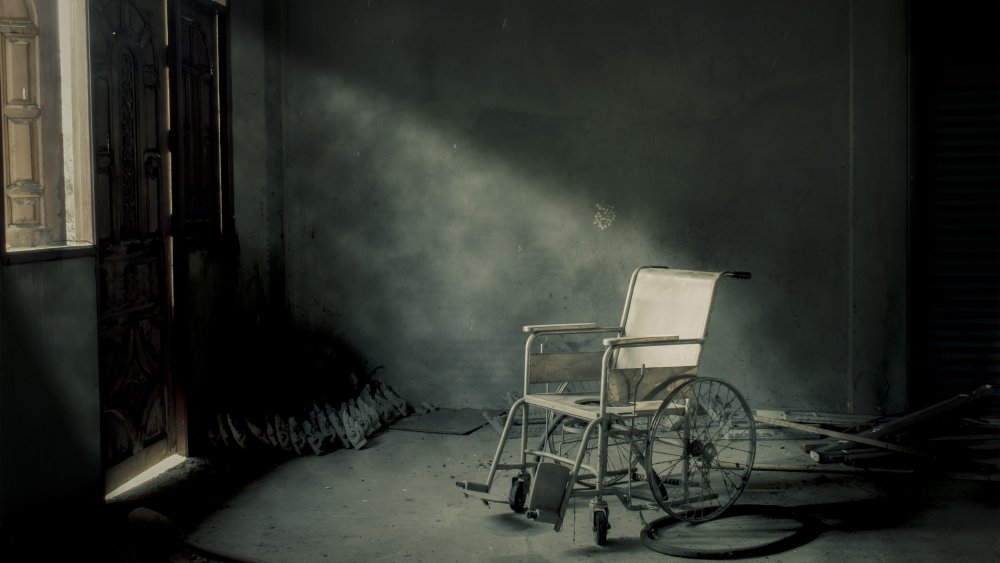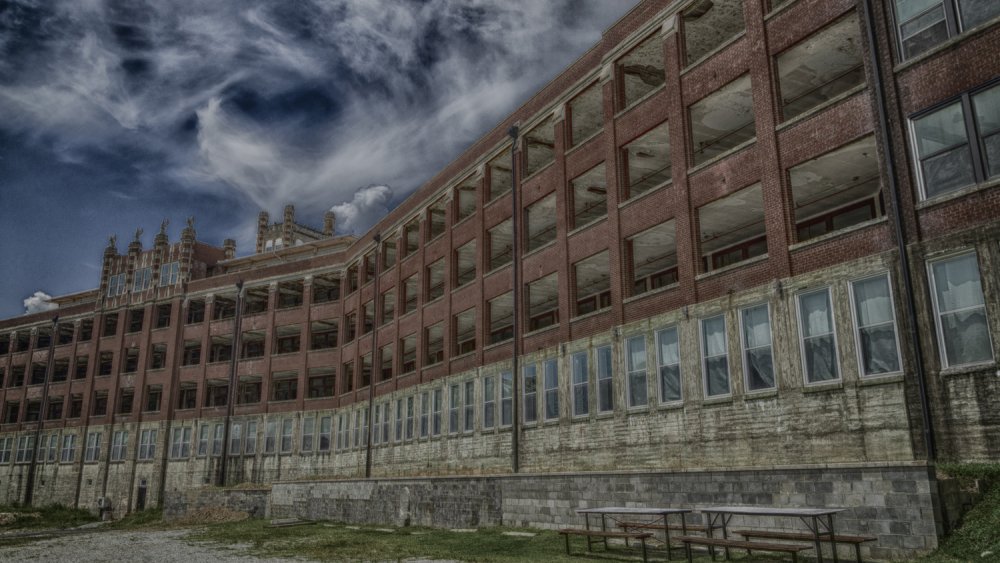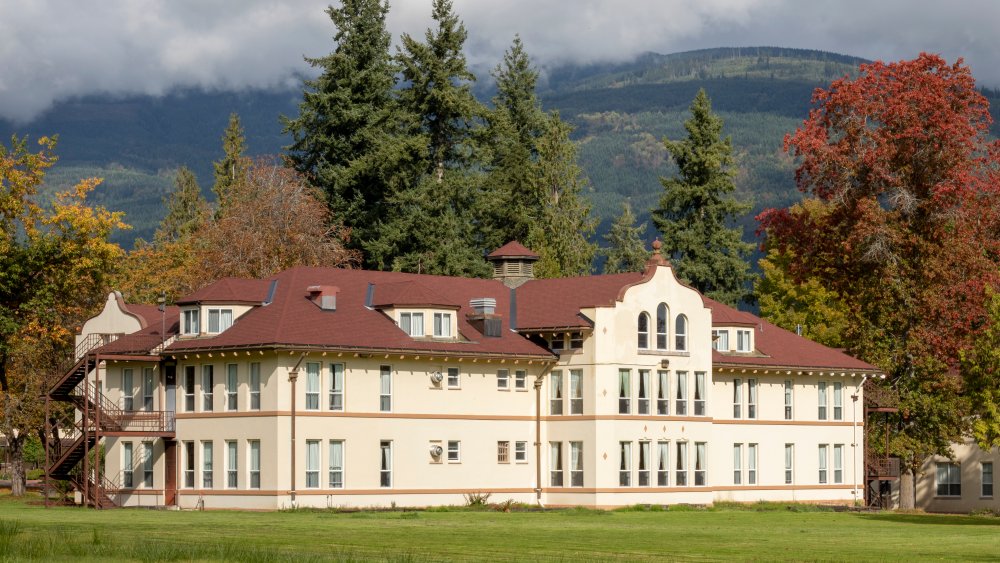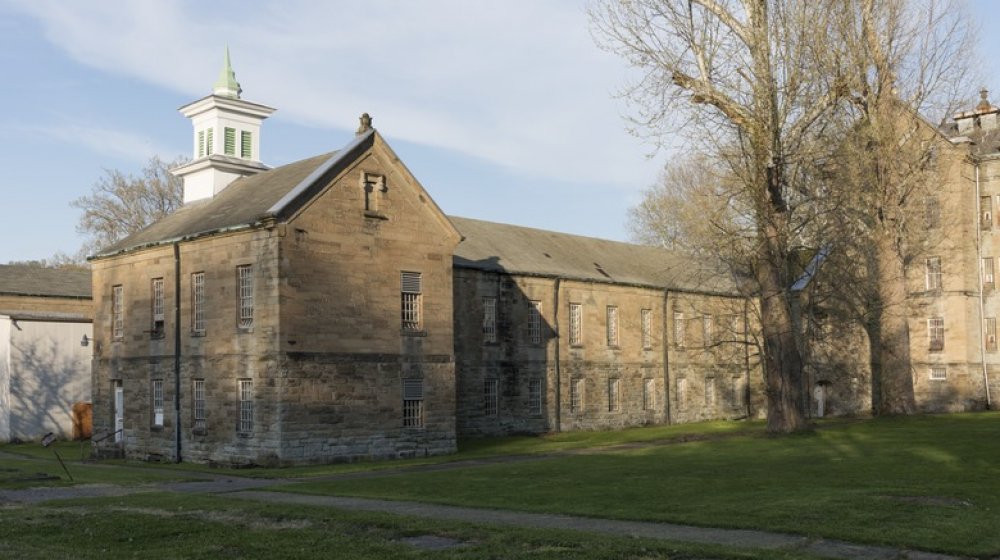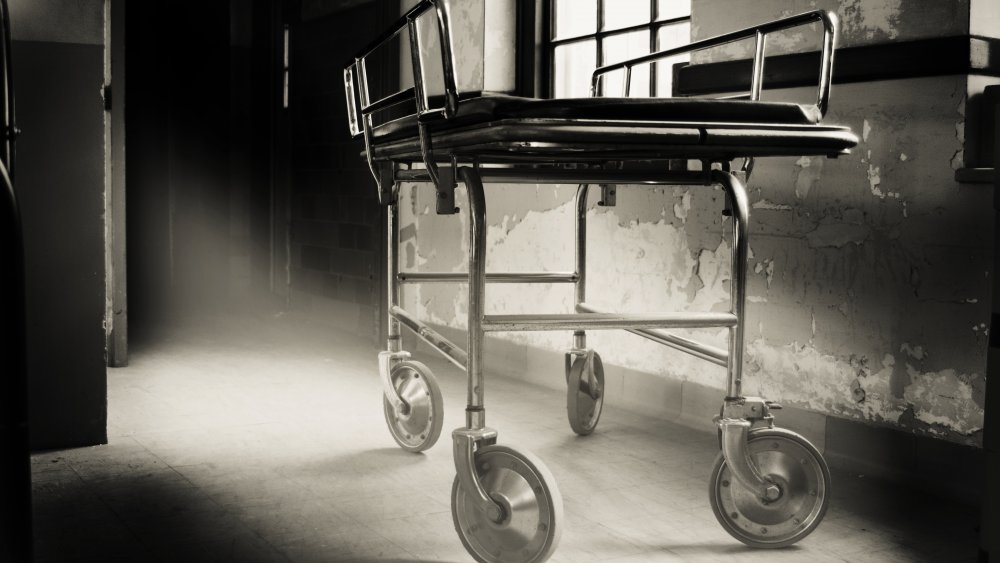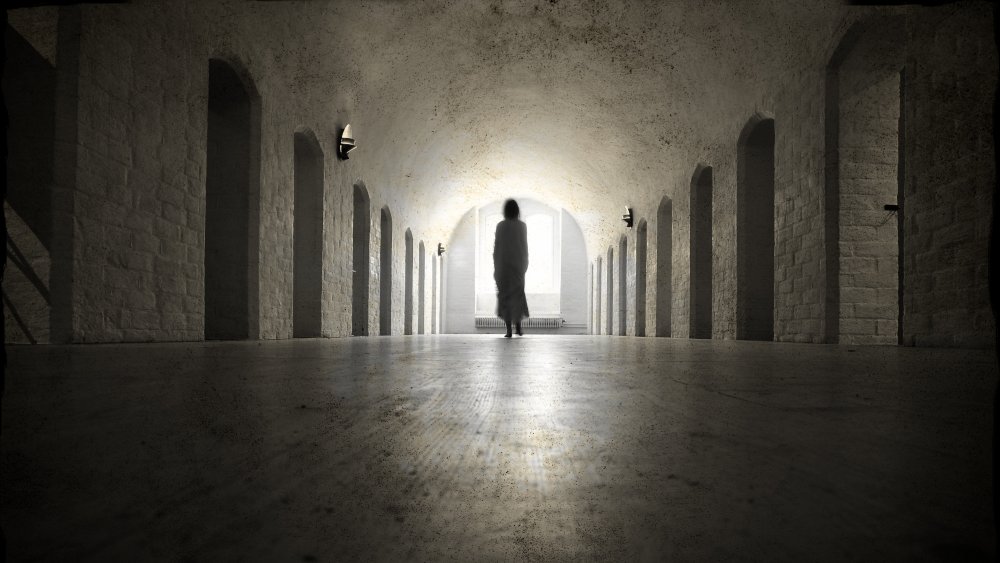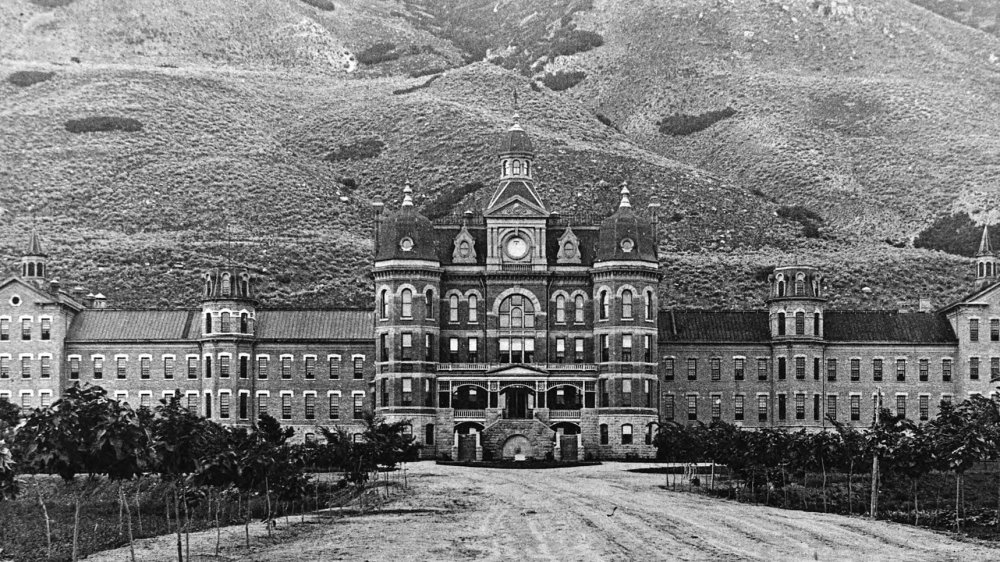Creepy Tales Of Hospital Ghosts
A hospital stay is never a welcome thing. Ill, injured, and weakened, people feel at their most vulnerable when they are laid up in a hospital bed. However, throughout history, some hospital stays have been worse than others. Certain groups of people, particularly the poor and mentally ill, have even been kept in sanatoriums or asylums against their will, and were subjected to traumatic and inhumane treatments at the hands of those charged with their care and well-being.
Perhaps that's why hospitals are known to be some of the most haunted buildings. Reports of paranormal sightings, ghosts, unruly spirits, and vengeful patients have plagued many famous hospitals. From Civil War ghosts to mental asylum inmates, many people believe some hospitals have admitted patients that have never left. To this day, they remain in the same buildings they spent their lives, wandering the halls, seeking the health and peace they were unable to find while alive.
The Waverly Hills Sanitorium in Louisville, Kentucky
In the early 1900s, the "White Plague" was ravaging Kentucky. Better known as tuberculosis, the disease spread throughout Louisville and Jefferson County, in an outbreak that would afflict the state for the next 60 years. Kentucky had a worse mortality rate than surrounding states, in part due to the crowded conditions at the local City Hospital, where tuberculosis patients were regularly treated, per Bricks and Mortar. The highly contagious disease needed to be contained, so in 1908, the county turned its attention to the land on Eighteenth-street Road, about 10 miles outside of Louisville city limits, per the Board of Tuberculosis Hospitals.
Formerly the site of a one-room schoolhouse, the Waverly Hills Sanatorium opened in 1910. Waverly Hills was a modern facility, treating its patients with fresh air, good nutrition, and lots of sunlight. However, because little was understood about the disease, patients also underwent much more traumatic treatments, including surgically implementing balloons and removing ribs, which were believed to improve lung function. Despite doctors' best efforts, thousands of people succumbed to the disease at Waverly.
To keep the sight of death away from the other patients, tunnels were constructed underneath the buildings to discreetly transport bodies outside and onto underground railways. Doctors believed that keeping corpses out of sight would be beneficial for the mental health of the others residing there. However, as the years went on, the so-called "Death Tunnels" began to gain notoriety, along with the rest of the sanatorium, for being haunted by the ghosts of people that died at Waverly.
It wasn't only patients that died in the Sanatorium. According to one legend, in the 1930s, a Waverly nurse who found herself unexpectedly pregnant hung herself outside of room 502. Another nurse supposedly committed suicide by jumping off the roof in 1932. These ghostly nurses are joined by sightings of a "man in white," a former surgeon who still haunts the halls of his former practice, reports of shadow people, and inanimate objects moving on their own. The most famous ghosts are that of Timmy and his friend Mary, two shadow children who still enjoy bouncing balls and playing hide and seek with visitors, per Dark Histories.
By 1961, the discovery of the antibiotic Streptomycin to treat tuberculosis had rendered sanatoriums obsolete. Waverly shut its doors, and over the years, the buildings began to fall into disrepair. In 2002, when Charlie Mattingly bought Waverly in an attempt to preserve the historic building, he found that the site frequently attracted explorers and ghost hunters from the surrounding areas, who were intrigued by the stories of haunted activity that had been circulating ever since the hospital closed its doors. Renovated and restored as an historic landmark, it is now known as one of the "most haunted places on earth," and thousands of paranormal tourists flock there every year to experience the hauntings for themselves, via The Waverly Hills Sanatorium.
Northern State Hospital in Sedro-Woolley, Washington
In the early 1900s, mental illness was poorly understood. People that suffered from mental illnesses were often isolated, locked away, and subjected to inhumane treatment and overcrowded conditions in insane asylums. In Washington State, the Western State Hospital was responsible for housing and treating the mentally ill for years, but by 1909, they had become overwhelmed and were unable to deal with increasing demands for beds. In response, the state authorized the construction of a new facility, and in 1912, the Northern State Hospital opened its doors.
It was more than an asylum. Renowned landscape architects John and Frederick Olstead built an entirely self-sufficient colony, covering over 1,100-acres of secluded land near Hansen Creek in Skagit County, per the Seattle Times. In addition to the hospital, the town boasted its own water reservoir, sewage system, housing, gym, library, and even a 700-acre farm, per Washington Trails Association. By the 1950s, 2,700 patients were living at Northern State, although not all were mentally ill. Some were merely poor immigrants, drug and alcohol addicts, or women suffering from depression. Despite its reputation as one of the more advanced and humane mental institutions of the time, patients were still forced to undergo a series of barbaric and traumatizing treatments, including electroshock therapy, sterilization, insulin-induced comas, and even trans-orbital lobotomies.
Most patients were admitted against their will, and many never left. Patients who died while undergoing treatment were buried in Northern State's adjoining cemetery, where some 1,500 bodies have been laid to rest, according to the Mountaineers. In 1976, after mass defunding from the state legislature, the hospital was forced to close. Most of the surrounding buildings have since been shuttered and largely forgotten. However, according to some recent sightings, there are patients that remain, and they have not forgotten about the treatment they suffered at Northern State. Paranormal investigators and ghost hunting visitors have reported seeing the spirits of deceased patients still wandering the Northern State Hospital building. The most commonly reported apparition is that of a nurse pushing a patient in a wheelchair down the halls, per Boston 25 News. Others have reported hearing moaning and screaming, and victims of trans-orbital lobotomies who died while undergoing the horrific operation are said to still wander the halls. Having undergone such troubling procedures while locked up at Northern State, many believe it may be the case that former patients are still struggling to find rest.
The Trans-Allegheny Lunatic Asylum in Weston, West Virginia
The Trans-Allegheny Lunatic Asylum opened in Weston, West Virginia, in 1864. Designed according to the Kirkbride Plan, the original goal was to construct a clean, bright, and comfortable building that would have a "curative effect" on the patients there, per the Trans-Allegheny Lunatic Asylum. It was only designed to house up to 250 people. Unfortunately, Trans-Allegheny would become famous not as a curative home for the ill, but as a house of horrors.
Before construction on the hospital was even finished, the site was already afflicted with conflict and loss. In 1861, after Virginia seceded from the Union, Confederate troops took over the partially-completed compound. Repurposing the southern wing for barracks and the asylum's foundation as a stable, the construction site became a vital military post known as Camp Tyler, per the Trans-Allegheny Lunatic Asylum.
Once the hospital began admitting patients in 1864, it quickly became clear that the need for beds far outpaced the available space. Trans-Allegheny fell victim to overcrowding. By 1880, 717 patients were crowded into rooms designed for less than half that, via Weston Hospital Revitalization Committee, and the problem got progressively worse. At its height in the 1950s, 2,600 patients were housed at Trans-Allegheny. Beds were crammed wherever they would fit, and some patients were forced to sleep in shifts. These were the lucky patients. Others were forced to sleep on freezing floors, and violent or unruly patients were even shackled to the wall.
Barbaric treatments were also performed on patients in an attempt to cure them. Patients were forced to undergo freezing hydrotherapy or were put into medically induced comas. Walter Freeman, the "father of the lobotomy" himself, performed ice pick lobotomies at Trans-Allegheny, per the Washington Post.
Not all trauma was suffered at the hands of the hospital staff. In the 1980s, the hospital incarcerated criminally insane patients, many of them violent. According to one story, two of these criminals brutally killed another resident, named Dean, with a bedpost. These days, Dean is said to haunt the halls, communicating with visitors through electronic voice phenomena, per the Ghost Research Society. Another spirit, who reportedly identified herself as Jane to ghost hunters, is thought to be the ghost of a woman who killed herself while incarcerated there. Ghosts of other former patients reportedly scream, bang, whistle, and even push visitors as they walk past. Although the hospital closed for good in 1994, it has regained a second life as a notoriously haunted place. The suffering and death that took place inside its walls have made the building a "recipe for trapped souls," according to paranormal investigator Zak Bagans (via Travel Channel). Having spent their lives locked inside its walls, it seems many uneasy spirits still remained trapped at Trans-Allegheny.
Old South Pittsburg Hospital in South Pittsburg, Tennessee
Known as one of the most haunted places in Tennessee, Old South Pittsburg Hospital sits directly above a natural spring on land that was once owned by the Chiaha Native American Tribe. Located in the foothill of South Pittsburg Mountain, it has been known to local ghost hunters since 1998, per Only In Your State. Before the hospital was even built, the land it was founded on was known as "Pittsburg Landing." The locale was an important transit point, where soldiers were able to easily ferry to the Chickamauga battlefield during the Civil War.
Before the war, the Chiaha tribe used the land for farming, hunting, and fishing. In the early 1860s, the Native American tribe granted Union soldiers permission to use the land for the transportation of artillery and supplies during the Civil War. However, this particular piece of land was a coveted spot, and Confederate soldiers frequently launched attacks and attempted to invade Pittsburg Landing. After much fighting, the Northern side managed to hang onto the land by the end of 1863, but not without heavy losses from both Union soldiers and their Native American allies, according to OSPHPRC.
Many believe the spirits of the Civil War dead haunted the land well before the construction of the Old South Pittsburg Hospital began in 1959. After the hospital opened and began admitting patients, many employees reported seeing evidence of paranormal activity while at work. Some have recounted stores of seeing inanimate objects like wheelchairs and hospital beds moving on their own. Others have reported seeing dark shadowy figures and hearing voices where there was no one present.
Unfortunately, the tragedies did not end with the opening of the hospital. Reports of abuse and neglect plagued the hospital, and its reputation worsened after a tragic fire in the 1920s killed seven children, per Haunted Journeys. Many believed the spirits of the deceased still linger in the corridors of the hospital. After the hospital officially closed its doors in 1998 to make room for a new hospital, locals were drawn to the old building to assess the truth of the haunted rumors for themselves.
Now a paranormal research center open for visits and tours, the site of the former Old South Pittsburg Hospital has a reputation for its famous ghosts. An angry, seven-foot tall surgeon haunts the third floor of the hospital, demanding outsiders leave the premises. In the basement, however, a promiscuous "naughty nurse" can be found whispering and flirting with the living visitors, per Haunted Journeys. Another ghost, an elderly woman named Hazel who lived in the hospital for only three days, is said to be heard screaming throughout the night. The second floor houses a more innocent spirit, a playful toddler named Buddy who reportedly urges visitors to join in his games or simply hold him. Whatever the reason, ghost hunters and casual visitors alike have reported feeling something otherworldly while visiting Old South Pittsburg Hospital.
Yorktown Memorial Hospital in Yorktown, Texas
In 1950, the Felician Sisters of the Roman Catholic Church felt the calling to help aid in the rehabilitation of those suffering from drug and alcohol addiction. They began building a rehab hospital in the quiet, secluded town of Yorkville, Texas, 75 miles southeast of San Antonio. Construction was completed in 1951, and Yorktown Memorial Hospital was run under the care of nuns until its closure in 1980, according to Texas Hill Country.
From the outset, they struggled to find employees, and the people they did find only brought trouble. According to Haunted Rooms, one of the nurses employed at Yorktown was embroiled in a love triangle. After being caught with her lover in the boiler room, the scorned man stabbed her to death in a rage before turning the knife on his rival. The rival was able to wrestle the knife away from the man, stabbing his attacker to death, resulting in two tragic murders (even if one was in self-defense). But perhaps the most troubling employee at Yorktown was Dr. Leon Norwierski, the facility's main doctor. Dr. Norwierski held the oldest medical license in Texas, but he was apparently far from a skilled surgeon. Instead, he reportedly made more than a few fatal mistakes while at work. Quite a few patients were known to die while under his care on the operating table, raising questions as to whether his fatal mistakes were really accidents.
The hospital's residents suffered from miserable conditionals and a dismal death rate. Around 500 patients died at Yorktown in just six years. All together, around 2,000 people are said to have died inside the hospital walls, according to Haunted Rooms, and some of their spirits may have never left. The building is now believed to be overrun with the ghosts of the lost, troubled souls who suffered while inside Yorktown's walls.
While the building is largely abandoned now, Yorktown's caretaker has reported encountering many spirits and haunted figures wandering the building in recent years. He has heard organ music, seen large moving black apparitions, and even witnessed red, glowing eyes on his shifts, per Haunted Places To Go. The ghosts of nuns also supposedly still haunt the site. However, rather than providing a nurturing presence, these ghosts are reportedly violent, attacking and scratching visitors they don't like. A paranormal investigations team called the Central Texas Ghost Hunters has seconded these claims, and even claimed to have captured the ghostly music on tape.
Utah State Hospital in Provo, Utah
In an interesting twist of events, the Utah State Hospital in Provo used their haunted reputation as a unique fundraising opportunity. The staff and patients at Utah State hosted an annual Haunted Castle inside the hospital every October from 1971 to 1997.
The Utah State Hospital was founded in 1885, but it was then called the Territorial Insane Asylum. Like many institutions in the late 19th and early 20th centuries, they suffered from overcrowding, poor treatment, and inadequate resources. However, rather than close when treatment turned away from asylum-based care in the 1960s and 1970s, the Utah State Hospital shifted its focus to providing community-based care. It remained open, providing physical and occupational therapy, specialized health care, and community activities for no more than 324 residents, via Utah.gov.
Even after the renovation, hospital staff reported seeing restless ghosts, whose spirits were still trapped inside the building where they had experienced so much suffering. One former psychiatric tech recalled the ghost of an old woman telling him: "Don't be afraid of the shadow people" on his first night at work, via the Beehive. Others experienced an uneasy presence in the basement that would sometimes shake doors or rattle locks, and several people claimed a black, shadowy figure was haunting the women's restroom.
Deciding to play off their haunted reputation, the hospital opened a small "spook alley" in 1971 for staff, patients, and families. Throughout the 1970s and 1980s, it became more popular. By 1995, the haunted house was raising over $100,000 in funds for the hospital, per Atlas Obscura. Many people saw the haunted house as an extension of their community-based vision, providing a stimulating creative project for patients to work on side-by-side with the staff.
For years, the Haunted Castle brought over 20,000 visitors to the hospital each Halloween season, shrieking in fear over the residents and volunteers dressed as monsters, mad scientists, and chainsaw-wielding murderers. However, these ghouls also caught the attention of people who were less frightened by the haunted asylum than they were troubled by the possible stigmas these terrifying "lunatics" might be perpetuating.
Activists and allies for mental health began advocating for the Castle's closure in 1997, saying the portrayal of the mentally ill as violent maniacs only advanced harmful stereotypes and increased stigma attached to the already vulnerable population. The National Alliance for the Mentally Ill called the performance a "freak show," that was "appalling, insulting and injurious to people with severe mental illnesses and their families," according to Deseret News. A vocal community of activists joined them in calling for an end to the Haunted Castle. Pat Baker, the director of the mental health nonprofit Allies for Families and whose daughter had briefly been a patient at Utah State Hospital, stated: "when you have a family member who has a serious mental illness...it is hurtful to have that person stereotyped as some kind of a maniac," via Atlas Obscura.
While the money raised from the haunted house was used for programs that benefited the residents, including paying for supplies and community outings, many people felt the ends did not justify the means. After much review and discussion, the hospital board voted to end the Haunted Castle in the beginning of 1998. These days, the most frightening ghosts at Utah State Hospital might still be the troubling history of psychiatric care in the United States, which was frequently barbaric, painful, and dehumanizing to those most in need of help.
